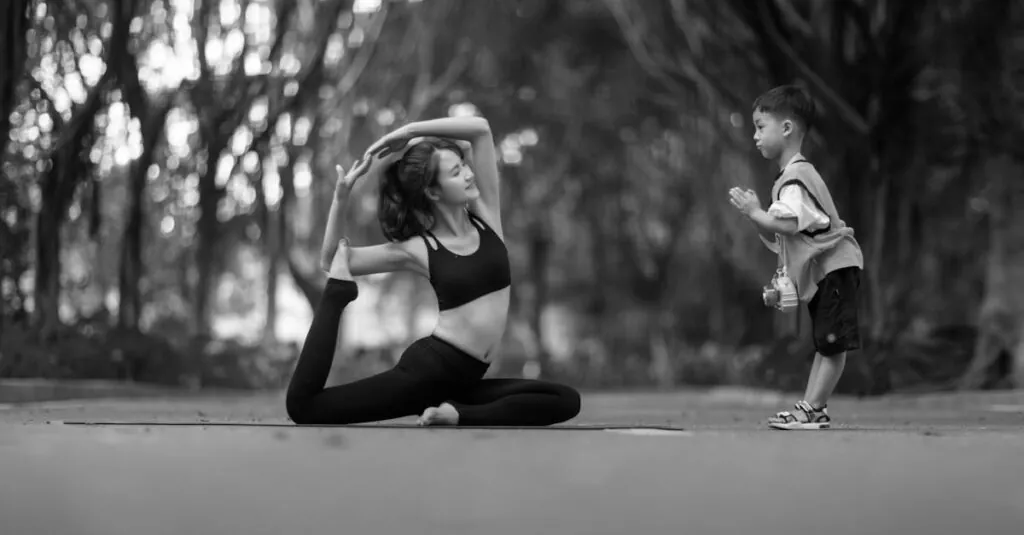Table of Contents
ToggleIn a world buzzing with distractions and endless to-do lists, finding a moment of peace can feel like searching for a unicorn in a haystack. But what if he told you that incorporating effective daily mindfulness practices could transform your chaotic routine into a serene sanctuary? Mindfulness isn’t just for yogis in flowing robes; it’s for anyone who wants to reclaim their sanity amidst the daily grind.
Understanding Mindfulness
Mindfulness involves being fully present in the moment, without judgment. This practice promotes awareness and allows individuals to experience their thoughts and feelings in a balanced way.
Definition of Mindfulness
Mindfulness is the process of acknowledging thoughts, emotions, and bodily sensations. Practitioners focus on the current experience without distraction. Techniques often include meditation, deep breathing, and observation. The act of grounding oneself in the present moment cultivates clarity and peace. Mindfulness isn’t limited to specific settings; it can be incorporated into daily activities, like eating or walking.
Benefits of Mindfulness
Mindfulness enhances emotional health and reduces stress. Studies show that regular practice lowers anxiety and depression levels. Improved focus and concentration often result from increased mindfulness, benefiting work performance. Better relationships can emerge as individuals respond with greater empathy. This practice can also lead to better physical health, improving sleep quality and reducing chronic pain. Mindfulness offers a holistic approach to well-being, impacting mental, emotional, and physical aspects of life.
Types of Mindfulness Practices
Mindfulness practices offer various techniques to cultivate awareness and presence. Engaging in these methods enhances emotional well-being while promoting serenity in everyday life.
Meditation Techniques
Meditation techniques form a core aspect of mindfulness. Focusing on the breath, one can use various patterns, such as counting breaths or practicing loving-kindness. In guided meditations, a teacher or an app provides instructions for deeper relaxation. Closing the eyes creates a tranquil environment, allowing thoughts to drift without attachment. Many individuals find that even five to ten minutes of meditation fosters clarity and reduces anxiety.
Breathing Exercises
Breathing exercises serve as powerful tools for mindfulness. Utilizing diaphragmatic breathing helps individuals tap into their body’s natural relaxation responses. Focusing on inhaling deeply through the nose, they then exhale slowly through the mouth. This technique can quickly alleviate stress and ground a person’s awareness. Practicing various rhythms, such as box breathing—four counts in, hold for four, four counts out, and hold for four—opens pathways to calmness and refocuses attention.
Body Scan
The body scan technique enhances bodily awareness through focused attention. Beginning at the toes, practitioners gradually explore sensations upward through the entire body. This method encourages relaxation by identifying areas of tension and consciously releasing them. Many choose to incorporate this practice into their bedtime routine, promoting better sleep. In just 10 to 15 minutes, a body scan cultivates a connection between the mind and body, enriching the overall mindfulness experience.
Creating a Daily Mindfulness Routine
Establishing a daily mindfulness routine enhances overall well-being. It cultivates presence and supports emotional health.
Setting Goals and Intentions
Setting clear goals and intentions focuses energy and direction. Identify specific outcomes, such as improving stress management or increasing emotional awareness. Write goals down, reinforcing commitment. Intentions serve as reminders to remain present throughout the day. Revisit these goals regularly, adjusting them as needed to reflect growth. Mindfulness practices gain depth and meaning when anchored in personal objectives.
Time Management for Mindfulness
Effective time management facilitates the incorporation of mindfulness into daily life. Allocate specific time blocks for mindfulness activities, whether it’s morning meditation or evening breathing exercises. Prioritize these moments just as one would for important meetings or tasks. Even short, mindful breaks during busy times rejuvenate focus. Utilize tools like reminders or calendar alerts to maintain consistency. By intentionally managing time, mindfulness becomes a natural part of the routine, fostering a sense of peace amid daily chaos.
Incorporating Mindfulness into Daily Activities
Incorporating mindfulness into daily activities creates opportunities for heightened awareness and calmness. Integrating simple practices encourages individuals to live fully in each moment.
Mindful Eating
Mindful eating promotes awareness of food choices and eating habits. Engaging the senses enhances the experience, allowing individuals to savor each bite. Observing textures, aromas, and flavors fosters a deeper appreciation for meals. Choosing to eat without distractions minimizes mindless consumption. Slowing down during meals aids digestion and promotes fullness cues. Practicing gratitude for food can deepen connections to health and nourishment. This deliberate approach to eating contributes to healthier relationships with food.
Mindful Walking
Mindful walking transforms an everyday activity into a meditative practice. Focusing on the mechanics of walking encourages awareness of body movements and surroundings. Taking note of sensations in the feet and legs enhances bodily connection. Observing the environment, such as sights and sounds, invites a sense of presence. Breathing rhythms can synchronize with steps, promoting relaxation. Choosing parks or quiet paths enhances exposure to nature. This simple integration of mindfulness provides clarity and relief from stress.
Overcoming Challenges in Mindfulness Practice
Practicing mindfulness can pose certain challenges, but recognizing and addressing these hurdles makes the journey smoother.
Dealing with Distractions
Distractions compete for attention during mindfulness practice. Individuals often notice that noise or a cluttered environment disrupts focus. Techniques such as finding a quiet space or using noise-cancelling headphones can help. Engaging in shorter mindfulness sessions may also sidestep distractions. Practicing mindfulness in nature offers a refreshing alternative, utilizing the surrounding calm to enhance focus. Turning off digital devices during practice sessions fosters a more immersive experience.
Staying Consistent
Maintaining consistency in mindfulness practice is crucial for experiencing its benefits. Setting specific times each day for practice encourages routine and habit formation. Creating visual reminders, like sticky notes or calendar alerts, can reinforce commitment. Starting with just a few minutes each day helps build gradually to longer sessions. Additionally, tracking progress in a journal fosters accountability and motivation. Connecting with a mindfulness community offers support and inspiration, making consistency easier to achieve.
Daily mindfulness practices offer a pathway to greater calm and clarity in today’s fast-paced world. By embracing techniques like meditation and mindful eating, individuals can cultivate a deeper connection to their thoughts and emotions. This journey not only enhances emotional health but also improves relationships and overall well-being.
Establishing a consistent mindfulness routine is essential for reaping these benefits. With intentional time management and clear goals, mindfulness can seamlessly integrate into daily life. As individuals navigate challenges and distractions, they’ll find that commitment and community support can significantly enhance their practice. Through these efforts, a more peaceful and fulfilling life is within reach.








